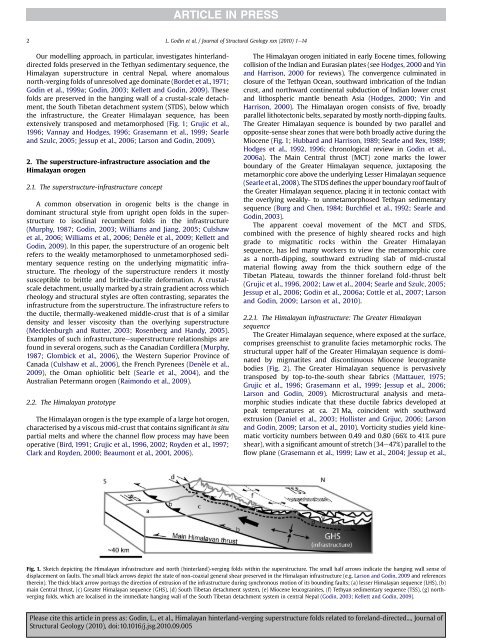Himalayan hinterland-verging superstructure folds related to ...
Himalayan hinterland-verging superstructure folds related to ...
Himalayan hinterland-verging superstructure folds related to ...
Create successful ePaper yourself
Turn your PDF publications into a flip-book with our unique Google optimized e-Paper software.
2L. Godin et al. / Journal of Structural Geology xxx (2010) 1e14Our modelling approach, in particular, investigates <strong>hinterland</strong>directed<strong>folds</strong> preserved in the Tethyan sedimentary sequence, the<strong>Himalayan</strong> <strong>superstructure</strong> in central Nepal, where anomalousnorth-<strong>verging</strong> <strong>folds</strong> of unresolved age dominate (Bordet et al., 1971;Godin et al., 1999a; Godin, 2003; Kellett and Godin, 2009). These<strong>folds</strong> are preserved in the hanging wall of a crustal-scale detachment,the South Tibetan detachment system (STDS), below whichthe infrastructure, the Greater <strong>Himalayan</strong> sequence, has beenextensively transposed and metamorphosed (Fig. 1; Grujic et al.,1996; Vannay and Hodges, 1996; Grasemann et al., 1999; Searleand Szulc, 2005; Jessup et al., 2006; Larson and Godin, 2009).2. The <strong>superstructure</strong>-infrastructure association and the<strong>Himalayan</strong> orogen2.1. The <strong>superstructure</strong>-infrastructure conceptA common observation in orogenic belts is the change indominant structural style from upright open <strong>folds</strong> in the <strong>superstructure</strong><strong>to</strong> isoclinal recumbent <strong>folds</strong> in the infrastructure(Murphy, 1987; Godin, 2003; Williams and Jiang, 2005; Culshawet al., 2006; Williams et al., 2006; Denèle et al., 2009; Kellett andGodin, 2009). In this paper, the <strong>superstructure</strong> of an orogenic beltrefers <strong>to</strong> the weakly metamorphosed <strong>to</strong> unmetamorphosed sedimentarysequence resting on the underlying migmatitic infrastructure.The rheology of the <strong>superstructure</strong> renders it mostlysusceptible <strong>to</strong> brittle and brittle-ductile deformation. A crustalscaledetachment, usually marked by a strain gradient across whichrheology and structural styles are often contrasting, separates theinfrastructure from the <strong>superstructure</strong>. The infrastructure refers <strong>to</strong>the ductile, thermally-weakened middle-crust that is of a similardensity and lesser viscosity than the overlying <strong>superstructure</strong>(Mecklenburgh and Rutter, 2003; Rosenberg and Handy, 2005).Examples of such infrastructuree<strong>superstructure</strong> relationships arefound in several orogens, such as the Canadian Cordillera (Murphy,1987; Glombick et al., 2006), the Western Superior Province ofCanada (Culshaw et al., 2006), the French Pyrenees (Denèle et al.,2009), the Oman ophiolitic belt (Searle et al., 2004), and theAustralian Petermann orogen (Raimondo et al., 2009).2.2. The <strong>Himalayan</strong> pro<strong>to</strong>typeThe <strong>Himalayan</strong> orogen is the type example of a large hot orogen,characterised by a viscous mid-crust that contains significant in situpartial melts and where the channel flow process may have beenoperative (Bird, 1991; Grujic et al., 1996, 2002; Royden et al., 1997;Clark and Royden, 2000; Beaumont et al., 2001, 2006).The <strong>Himalayan</strong> orogen initiated in early Eocene times, followingcollision of the Indian and Eurasian plates (see Hodges, 2000 and Yinand Harrison, 2000 for reviews). The convergence culminated inclosure of the Tethyan Ocean, southward imbrication of the Indiancrust, and northward continental subduction of Indian lower crustand lithospheric mantle beneath Asia (Hodges, 2000; Yin andHarrison, 2000). The <strong>Himalayan</strong> orogen consists of five, broadlyparallel lithotec<strong>to</strong>nic belts, separated by mostly north-dipping faults.The Greater <strong>Himalayan</strong> sequence is bounded by two parallel andopposite-sense shear zones that were both broadly active during theMiocene (Fig. 1; Hubbard and Harrison, 1989; Searle and Rex, 1989;Hodges et al., 1992, 1996; chronological review in Godin et al.,2006a). The Main Central thrust (MCT) zone marks the lowerboundary of the Greater <strong>Himalayan</strong> sequence, juxtaposing themetamorphic core above the underlying Lesser <strong>Himalayan</strong> sequence(Searle et al., 2008). The STDS defines the upper boundary roof fault ofthe Greater <strong>Himalayan</strong> sequence, placing it in tec<strong>to</strong>nic contact withthe overlying weakly- <strong>to</strong> unmetamorphosed Tethyan sedimentarysequence (Burg and Chen, 1984; Burchfiel et al., 1992; Searle andGodin, 2003).The apparent coeval movement of the MCT and STDS,combined with the presence of highly sheared rocks and highgrade <strong>to</strong> migmatitic rocks within the Greater <strong>Himalayan</strong>sequence, has led many workers <strong>to</strong> view the metamorphic coreas a north-dipping, southward extruding slab of mid-crustalmaterial flowing away from the thick southern edge of theTibetan Plateau, <strong>to</strong>wards the thinner foreland fold-thrust belt(Grujic et al., 1996, 2002; Law et al., 2004; Searle and Szulc, 2005;Jessup et al., 2006; Godin et al., 2006a; Cottle et al., 2007; Larsonand Godin, 2009; Larson et al., 2010).2.2.1. The <strong>Himalayan</strong> infrastructure: The Greater <strong>Himalayan</strong>sequenceThe Greater <strong>Himalayan</strong> sequence, where exposed at the surface,comprises greenschist <strong>to</strong> granulite facies metamorphic rocks. Thestructural upper half of the Greater <strong>Himalayan</strong> sequence is dominatedby migmatites and discontinuous Miocene leucogranitebodies (Fig. 2). The Greater <strong>Himalayan</strong> sequence is pervasivelytransposed by <strong>to</strong>p-<strong>to</strong>-the-south shear fabrics (Mattauer, 1975;Grujic et al., 1996; Grasemann et al., 1999; Jessup et al., 2006;Larson and Godin, 2009). Microstructural analysis and metamorphicstudies indicate that these ductile fabrics developed atpeak temperatures at ca. 21 Ma, coincident with southwardextrusion (Daniel et al., 2003; Hollister and Grijuc, 2006; Larsonand Godin, 2009; Larson et al., 2010). Vorticity studies yield kinematicvorticity numbers between 0.49 and 0.80 (66% <strong>to</strong> 41% pureshear), with a significant amount of stretch (34e47%) parallel <strong>to</strong> theflow plane (Grasemann et al., 1999; Law et al., 2004; Jessup et al.,Fig. 1. Sketch depicting the <strong>Himalayan</strong> infrastructure and north (<strong>hinterland</strong>)-<strong>verging</strong> <strong>folds</strong> within the <strong>superstructure</strong>. The small half arrows indicate the hanging wall sense ofdisplacement on faults. The small black arrows depict the state of non-coaxial general shear preserved in the <strong>Himalayan</strong> infrastructure (e.g. Larson and Godin, 2009 and referencestherein). The thick black arrow portrays the direction of extrusion of the infrastructure during synchronous motion of its bounding faults; (a) lesser <strong>Himalayan</strong> sequence (LHS), (b)main Central thrust, (c) Greater <strong>Himalayan</strong> sequence (GHS), (d) South Tibetan detachment system, (e) Miocene leucogranites, (f) Tethyan sedimentary sequence (TSS), (g) north<strong>verging</strong><strong>folds</strong>, which are localised in the immediate hanging wall of the South Tibetan detachment system in central Nepal (Godin, 2003; Kellett and Godin, 2009).Please cite this article in press as: Godin, L., et al., <strong>Himalayan</strong> <strong>hinterland</strong>-<strong>verging</strong> <strong>superstructure</strong> <strong>folds</strong> <strong>related</strong> <strong>to</strong> foreland-directed..., Journal ofStructural Geology (2010), doi:10.1016/j.jsg.2010.09.005
















